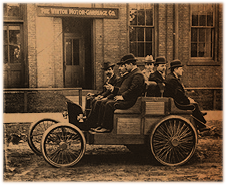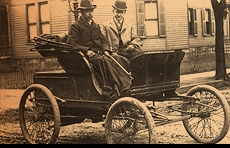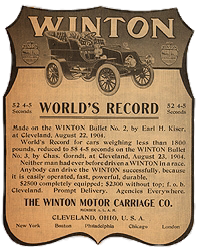Winton Remembered in New BookCleveland, OH - When's the last time you used your brakes and you thought of Alexander Winton? "Alexander who?" is most likely your response. Which is precisely why two automotive buffs sat down to document the accomplishments of a little-known automotive pioneer. "Famous But Forgotten: The Story of Alexander Winton" by Clevelanders Thomas F. Saal and Bernard J. Golias details Winton's fascination with motion and power, from his beginnings as a bicycle manufacturer on Cleveland's West Side to his design and development of high-end automobiles. |
"People tend to equate Henry Ford with all the major automotive accomplishments," Golias says. "But if you take a look at the early patents, Winton held the groundbreakers in automotive development." Winton's legacy includes more than 100 patents instrumental in the early designs of automobiles and diesel engines. He was also generous in passing the technology along to competitors when safety was an issue. The book indicates that prior to the Grosse Pointe Race in 1901, Winton gave Henry Ford one of his new complete steering mechanisms with a steering wheel assembly because Winton said somebody would get killed with the device Ford was using. Ford went on the win the Gross Pointe Race, but Winton consoled himself that it was with his steering gear. |
The 192-page book includes numerous photographs of vintage Winton automobiles and their accomplishments in performance races. Winton's career, from bicycle manufacturer to automotive innovator to diesel-engine developer for trains, illustrates the versatility which his prodigious creativity required. |
It's a FactIn Cleveland... After Alexander Winton produced his first horseless carriage in 1896, he was followed by many others. By 1930, over 80 different nameplates had graced radiators of automobiles made in Cleveland. In 1904 the city was the nation's largest auto producer. Although Cleveland eventually lost the "Motor City" title to Detroit, Cleveland has long been the nation's second largest manufacturer of automotive components.
WantedWinton Automobile, Bicycle and diesel literature, postcards, letters, factory magazines; "The Auto Era," Ephemera, photos, miscellaneous memorabilia.
Bernie Golias |
On The Road Again
by Christopher Jensen The opportunity to drive an 1899 Winton is a special thing, and it should be the occasion for meaningful thought about automotive history. In particular, it should occasion thoughts of Cleveland's Alexander Winton, one of America's automotive pioneers. Instead, I'm obsessing about stopping the, uh, darn thing. I am with Charles F. Wake, one of Winton's great-grandsons, and we are sitting on the cutest little tufted seat, no doubt spiritual kin to Chrysler's "rich Corinthian leather." We are driving one of three 1899 Wintons in the world, this one belonging Cleveland's Frederick C. Crawford Auto Aviation Museum. The 8-horsepower, one-cylinder 117-cubic-inch engine is mounted below and behind us. It is banging away, and It sounds like the world's loudest smoker's cough. We are cruising down the street at 10 miles per hour. The 1899 will clearly go faster but that means plenty quick, as I am still getting used to the lack of seat belts and have doubts about the car's stopping ability, an important part of which seems to be a Jeaune Dixon-like ability to predict the future. "You want to plan well in advance... shoot off flares," advised David Holcombe, curator of the museum, a co-sponsor of the event.
Enormous funOther than this trifling problem with inertia, driving a Winton designed about 100 years ago is not all that hard. In fact, it is enormous fun. At least it is fun for half a mile or so. "Driving this is a trip," agreed Wake, of Sarasota, Fla. The question is, how will Wake and I feel after driving the 1899 Winton 700 miles? Starting Sunday at 8 a.m., we will leave Public Square for New York City to commemorate a drive Winton made 100 years ago. Actually, there will be 14 Wintons, the newest a 1922 model. Another Winton great-grandson, James A. Winton Jr. of Rocky River, will drive a 1916 model. In theory, we will reach New York on June 22 and our misadventures will be recounted in The Plain Dealer's Driving section June 29. |
The trip is called the Winton Centennial, and Wake and Winton (so far) are unindicted co-conspirators. There was also the enthusiastic support of Holcombe and co-sponsorship from the Crawford museum. Several years ago, when Wake and Winton were trying to figure out some way to commemorate the 1897 trip, Holcombe suggested driving the route again. It was an outrageous and tragically contagious idea that quickly gained momentum - and then acceptance. You only live twice Winton actually drove to New York twice. On July 28, 1897, Winton and an employee headed for New York to prove the reliability of his vehicle, according to "Famous But Forgotten: The Story of Alexander Winton, Automotive Pioneer and Industrialist," a new book by Clevelanders Thomas F. Saal and Bernard J. Golias that will be published tomorrow. Winton arrived in New York on Aug. 7 of that year, after 78 hours and 43 minutes of driving time. The problem was that nobody cared. Winton got little attention, which was disappointing, since publicity was the whole idea. Long before Jacqueline Susann thought about it, Winton decided that once was not enough, and two years later he hooked up with journalist Charles B. Shanks. Shanks had been a Plain Dealer reporter before going to fight in the Spanish-American War, according to Saal and Golias. Accounts as to how the two got together differ. There is a story that Winton paid Shanks $100 to go with him, and another story that the trip was the result of a bet, with Shanks rudely doubting the reliability of the Winton. In any case, they decided to drive to New York. The Plain Dealer would sponsor the trip and Shanks would report on it.
'Mud Galore'The trip began on May 22, 1899, with a Plain Dealer story the previous day announcing "Novel Method of Transport. The Plain Dealer is Sending a Horseless Carriage to New York." The story noted that "the automobile will doubtless become the most convenient mode of transport during the 20th century. The Plain Dealer is... |


